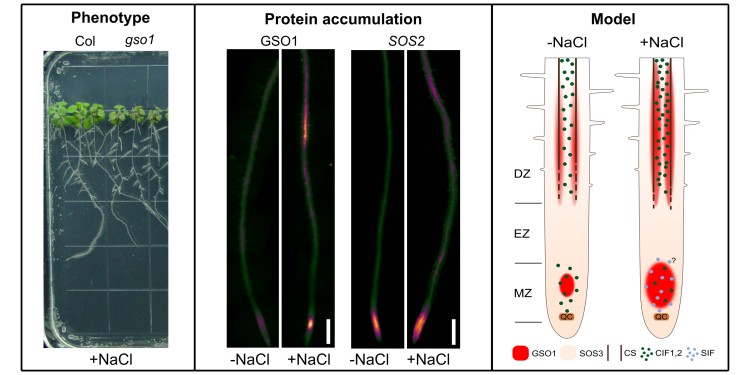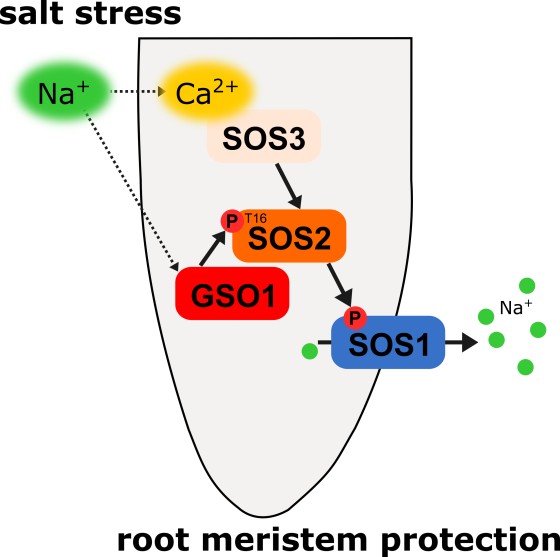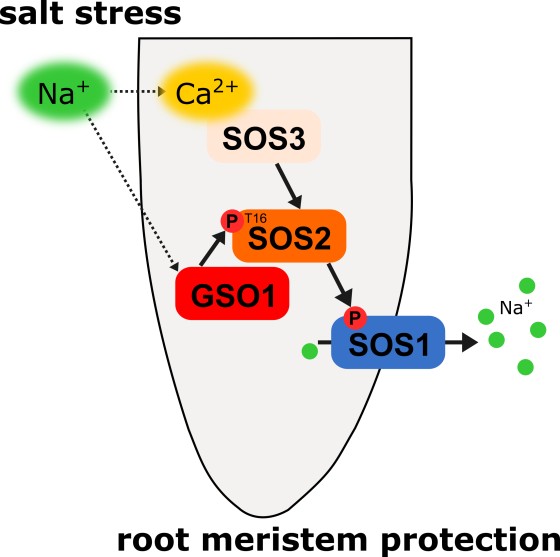Münster, Germany
May 23, 2023
 GSO1 is important for plant salt stress tolerance. Left: Loss-of-function mutants of GSO1 (gso1) exhibit reduced root and shoot growth in the presence of salt stress as compared to wildtype (Col). Middle: Salt stress induces enhanced GSO1 receptor kinase accumulation specifically in the root tip meristem and in the endodermis of the differentiation zone. The kinase SOS2 is present in the whole root; its protein accumulation is evenly enhanced upon salt stress. Right: Model of salt stressed Arabidopsis roots. - © Chen C. et al./The EMBO Journal (2023)e113004
GSO1 is important for plant salt stress tolerance. Left: Loss-of-function mutants of GSO1 (gso1) exhibit reduced root and shoot growth in the presence of salt stress as compared to wildtype (Col). Middle: Salt stress induces enhanced GSO1 receptor kinase accumulation specifically in the root tip meristem and in the endodermis of the differentiation zone. The kinase SOS2 is present in the whole root; its protein accumulation is evenly enhanced upon salt stress. Right: Model of salt stressed Arabidopsis roots. - © Chen C. et al./The EMBO Journal (2023)e113004
Newly discovered signalling pathway specifically protects the stem cells in the plant root from salt stress
A high content of sodium-containing salts in the soil is a problem for many plants: as a result, they grow less well, or not at all. Soil salinisation is seen as one of the greatest threats to being able to feed the world’s population because it makes soils increasingly infertile, especially in dry regions. A team of Chinese, German and Spanish researchers, including Prof Jörg Kudla and his team from the University of Münster, has now found a mechanism in thale cress (Arabidopsis thaliana) which enables plants to provide protection against salt stress for their sensitive stem cells in the meristem at the root tip. The meristem, which ensures that the root constantly forms new cells and can thus grow, is particularly sensitive: in contrast to fully formed plant cells, its cells have no vacuole inside where harmful substances can be disposed of.
The discovery that plants can provide protection against toxic salt stress specifically for individual groups of cells came as something of a surprise to the researchers. Although it was already known that there are various mechanisms in plants enabling them to cope with high salt contents in soil water – one is an active transportation of salt out of the cells, another is the mechanical impregnation of a specific cell layer in the root – what was not known was that plants also specifically protect the stem cells in their roots. “The signalling pathway we have discovered – which combines components of known salt-stress signalling pathways with signalling proteins for the purpose of controlling root development – serves the additional purpose of specifically detoxifying the plant,” says Jörg Kudla.
 S
S
alt stress (Na+) triggers a Ca2+ signal in roots. This signal is translated into the activation of the Na+ exporter SOS1 via the SOS pathway. The Ca 2+ -independent activation of the SOS2-SOS1 module through the receptor kinase GSO1 constitutes a novel mechanism of plant salt stress tolerance. This mechanism especially protects the stem cells in the root meristem from the toxic effects of high Na+ concentrations. - © L. Wallrad/ The EMBO Journal
(2023)e113004
The mechanism in detail: a special enzyme – a receptor-like kinase called GSO1 – transports the sodium out of the cells of the meristem. To this end, GSO1 activates the kinase SOS2 (SOS stands for “salt overly sensitive”), and this in turn activates a transport protein (SOS1) which pumps sodium ions outwards, via the cell membrane, and, in return, transports protons into the cell. In the case of salt stress, there is an increased formation of GSO1 especially in the meristem cells.
In addition, the team demonstrated that GSO1 also helps to prevent too much salt from penetrating into the vascular tissue of the root. This vascular tissue is located in the interior of the plant and transports water and minerals from the roots into the leaves. By a mechanical barrier, the Casparian strip, it is protected from minerals dissolved in the soil water penetrating into it in an uncontrolled fashion. The researchers also demonstrated a higher GSO1 content in the cells forming the Casparian strip increases due to salt stress.
“GSO1 is a receptor kinase well known in plant developmental biology,” says Jörg Kudla. “It plays an important role in various stages in a plant’s development. Now, for the first time, we were able to demonstrate that it also plays a role in salt tolerance and activates the ‘sodium-out pump’ via an alternative signalling pathway which is presumably not dependent on calcium.” Calcium signals in the cells play a key role in other known adaptive responses of plants to salt stress.
About the methods: The team discovered the significance of GSO1 by comparing numerous mutants of various receptor-like kinases in the thale cress. By studying protein interactions, they identified the reaction partners of the enzyme within the signalling pathways for protecting the meristem and forming the Casparian strip. Methods used in further investigations included mass spectrometry and high-resolution microscopy.
The work received financial support from the National Natural Science Foundation of China and from the German Research Foundation (DFG) for a joint project undertaken by teams from Münster and Beijing, as well as from the National Basic Research Program of China, Spain’s Agencia Estatal de Investigación, the European Regional Development Fund and the Chinese Scholarship Council.
Original publication
Changxi Chen, Gefeng He, Jianfang Li, Javier Perez-Hormaeche, Tobias Becker, Manqing Luo, Lukas Wallrad, Jia Li, José M. Pardo, Jörg Kudla, Yan Guo (2023): A salt stress-activated GSO1-SOS2-SOS1 module confers Na+ extrusion for root meristem protection. The EMBO Journal (2023) e113004; DOI: 10.15252/embj.2022113004
Forscher finden neuen Mechanismus für die Salz-Entgiftung in Pflanzen
Neu entdeckter Signalweg schützt gezielt die Stammzellen der Pflanzenwurzel vor Salzstress
Ein hoher Gehalt an natriumhaltigen Salzen im Boden ist für viele Pflanzen ein Problem – sie wachsen schlechter oder gar nicht mehr. Bodenversalzung gilt als eine der größten Bedrohungen für die Ernährung der Weltbevölkerung, denn sie macht Böden zunehmend unfruchtbar, besonders in trockenen Regionen. Ein chinesisch-deutsch-spanisches Team von Wissenschaftlern, darunter Prof. Dr. Jörg Kudla und seine Mitarbeiter von der Westfälischen Wilhelms-Universität (WWU) Münster, hat nun bei der Acker-Schmalwand (Arabidopsis thaliana) einen Mechanismus gefunden, mit dem die Pflanzen die empfindlichen Stammzellen ihres Bildungsgewebes in der Wurzel vor Salzstress schützen. Das Bildungsgewebe, Meristem genannt, sorgt dafür, dass die Wurzel ständig neue Zellen bildet und somit wachsen kann. Es ist besonders empfindlich; seine Zellen haben im Gegensatz zu fertig ausgebildeten Pflanzenzellen keine Vakuole im Inneren, in die Schadstoffe entsorgt werden können.
Die Entdeckung, dass Pflanzen einzelne Zellgruppen gezielt vor toxischem Salzstress schützen, kam für das Forschungsteam überraschend. Zwar war bekannt, dass es in Pflanzen verschiedene Mechanismen gibt, um mit hohem Salzgehalt im Bodenwasser klarzukommen: zum einen das aktive Heraustransportieren von Salz aus den Zellen, zum anderen die mechanische Imprägnierung einer spezifischen Zellschicht der Wurzel. Dass Pflanzen zusätzlich speziell ihre Wurzelstammzellen schützen, war jedoch nicht bekannt. „Der von uns entdeckte Signalweg, der Komponenten bekannter Salzstress-Signalwege mit Signalproteinen zur Steuerung der Wurzelentwicklung vereint, dient einer zusätzlichen, spezifischen Entgiftung der Pflanze“, unterstreicht Jörg Kudla.

Salzstress (Na+) löst ein Kalzium-Signal (Ca2+) in Wurzeln aus. Dadurch wird über den SOS-Signalweg das Na+- Exportprotein SOS1 aktiviert. Die Kalzium-unabhängige Aktivierung des SOS2-SOS1-Moduls durch die Rezeptorkinase GSO1 ist ein neuer Mechanismus der pflanzlichen Salztoleranz. Dieser schützt insbesondere die Stammzellen im Meristem der Wurzelspitze vor den toxischen Effekten erhöhter Salzkonzentrationen. - © L. Wallrad/The EMBO Journal (2023)e113004
Der Mechanismus im Detail: Ein spezielles Enzym, eine sogenannte rezeptorähnliche Kinase mit der Bezeichnung GSO1, fördert den Natrium-Transport aus den Zellen des Meristems. GSO1 aktiviert dazu die Kinase SOS2 (SOS steht für „Salt Overly Sensitive“, also etwa „überempfindlich gegen Salz“) und diese wiederum ein Transportprotein (SOS1), welches Natrium-Ionen über die Zellmembran nach außen pumpt und im Gegenzug Protonen in die Zelle transportiert. Bei Salzstress wird GSO1 besonders in den Meristemzellen verstärkt gebildet.
Außerdem belegte das Team, dass GSO1 auch dazu beiträgt, das Eindringen von zu viel Salz in das Leitgewebe der Wurzel zu verhindern. Das Leitgewebe liegt im Inneren der Pflanze und transportiert Wasser und Mineralstoffe von den Wurzeln bis in die Blätter. Es ist durch eine mechanische Barriere – den Casparischen Streifen – gegen das unkontrollierte Eindringen von Wasser und den darin gelösten Mineralstoffen geschützt. Auch in den Zellen, die den Casparischen Streifen bilden, wiesen die Forscher einen durch Salzstress erhöhten GSO1-Gehalt nach.
„GSO1 ist eine in der pflanzlichen Entwicklungsbiologie bekannte Rezeptorkinase. Sie spielt bei verschiedenen Entwicklungsschritten der Pflanze eine wichtige Rolle. Wir konnten jetzt erstmals nachweisen, dass sie auch eine Rolle bei der Salztoleranz spielt und die ‚Natrium-raus-Pumpe‘ über einen alternativen, vermutlich von Kalzium unabhängigem Signalweg aktiviert“, erläutert Jörg Kudla. Kalziumsignale in den Zellen spielen bei anderen bekannten Anpassungsreaktionen von Pflanzen auf Salzstress eine zentrale Rolle.
Zu den Methoden: Das Team stieß durch einen Vergleich zahlreicher Mutanten von verschiedenen rezeptorähnlichen Kinasen der Acker-Schmalwand auf die Bedeutung von GSO1. Durch Protein-Interaktionsstudien identifizierten sie die Reaktionspartner des Enzyms innerhalb der Signalwege zum Schutz des Meristems und zur Bildung des Casparischen Streifens. Zu den in weiteren Untersuchungen eingesetzten Methoden zählten Massenspektrometrie und hochauflösende Mikroskopie.
Die Arbeit erhielt finanzielle Unterstützung von der National Natural Science Foundation of China und der Deutsche Forschungsgemeinschaft (DFG) für ein gemeinsames Forschungsprojekt der Arbeitsgruppen aus Münster und Peking sowie durch das National Basic Research Program of China, die spanische Agencia Estatal de Investigacion, den European Regional Development Fund und den Chinese Scholarship Council.
Originalveröffentlichung
Changxi Chen, Gefeng He, Jianfang Li, Javier Perez-Hormaeche, Tobias Becker, Manqing Luo, Lukas Wallrad, Jia Li, José M. Pardo, Jörg Kudla, Yan Guo (2023): A salt stress-activated GSO1-SOS2-SOS1 module confers Na+ extrusion for root meristem protection. The EMBO Journal (2023) e113004; DOI: 10.15252/embj.2022113004